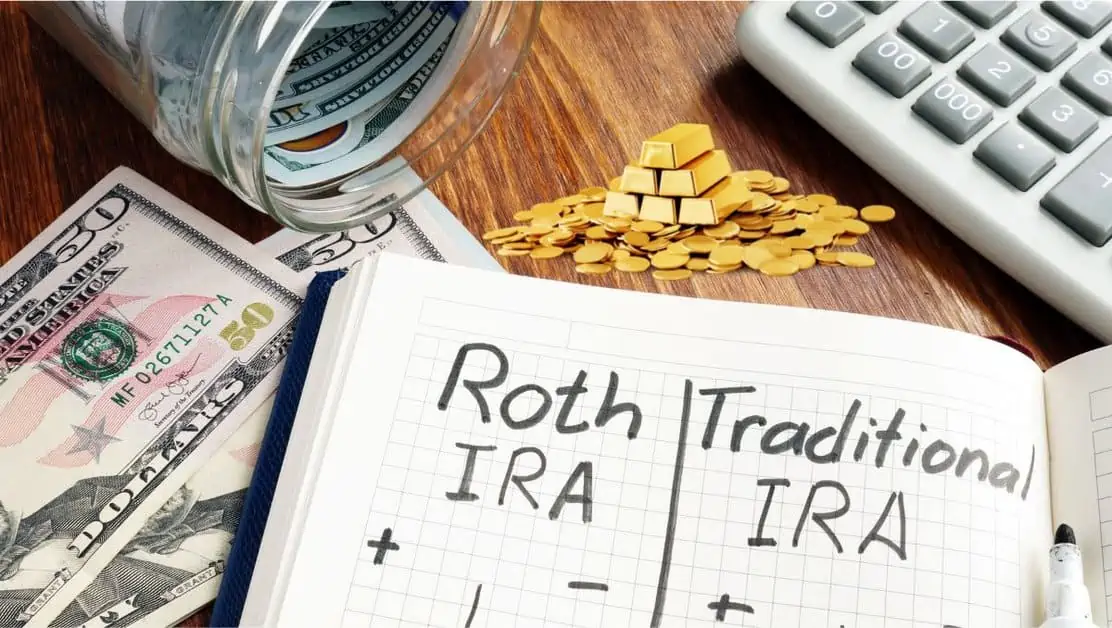7 Different Types of IRA Accounts For Retirement And Their Benefits
WiseCatcher is supported by its readers and we earn a commission if you buy through our affiliate links at no extra cost. Read the full affiliate disclosure in our privacy policy.
WiseCatcher is supported by its readers. You can find full affiliate disclosure in our privacy policy.

Choosing an IRA account for retirement can be tricky. There are many different opportunities to choose from. There are seven different types of Individual Retirement Accounts (IRA).
Choosing the right and best IRA can significantly impact how much money you will have when you retire. We’ll show you all types of IRA accounts, their benefits, and some essential FQAs related to IRA Accounts.
You’ll find the differences between each IRA type and make the right decision for your financial future.
Find the right IRA account for your retirement needs with this helpful guide, including information on Traditional IRAs, Roth IRAs, SEP IRAs, SIMPLE IRAs, Spousal IRAs, Non-deductible IRAs and Rollover IRAs. Let’s get started.
What is an IRA account?
An Individual Retirement Account (IRA) Account is a popular way for individuals to save funds for their retirement because they offer tax advantages that can help grow the money in the account faster than in regular savings or investment accounts.
There are various types of IRAs, including traditional IRAs, Roth IRAs, Gold IRAs, and SEP IRAs, each of which has specific rules and eligibility requirements.
In general, IRAs allow individuals to save a certain amount each year on a tax-deferred basis, meaning that the money in the account can grow without being subject to income tax until it is withdrawn during retirement.
Read our comprehensive guide on the 17 best Gold IRA companies for 2023.
What Are the Different Types of IRA Accounts?
Individual Retirement Accounts (IRAs) are a popular retirement savings option for many Americans. They offer tax advantages, flexibility, and a range of investment options.
Here are seven best types of IRAs accounts to invest for retirement:
1. Traditional IRA
Traditional IRAs are the most common type. They allow individuals to contribute pre-tax money to a retirement account. It means that the money contributed is not taxed until it is withdrawn in retirement.
Contributions are generally tax-deductible, so individuals can lower their taxable income in the year they contribute. Traditional IRAs also offer tax-deferred growth, meaning earnings and interest are not taxed until withdrawn.
2. Roth IRA
Roth IRAs are similar to Traditional IRAs but are funded with after-tax dollars. It means that the money contributed to a Roth IRA grows tax-free, and you don’t have to pay taxes at the time of withdrawal during retirement.
Roth IRAs are not tax-deductible, but they provide tax-free growth and distributions, making them an attractive alternative to traditional IRAs for individuals who expect to be in a higher tax bracket when they retire.
3. Non-deductible IRA
A nondeductible IRA is an individual retirement account (IRA) that is not tax-deductible. It means that contributions to a nondeductible IRA are made with after-tax dollars rather than pre-tax dollars, like with a traditional IRA or a deductible Roth IRA.
While contributions to a nondeductible IRA are not tax deductible, the earnings on the investments within the account may still be tax-deferred.
Nondeductible IRAs are typically used by individuals who do not qualify for a traditional IRA or a deductible Roth IRA due to income restrictions.
You can use them to save for retirement if you have already maxed out your contributions to other retirement accounts, such as a 401(k) or a traditional IRA.
4. SEP IRA
Simplified Employee Pension (SEP) IRAs are designed for self-employed individuals and small business owners. They allow for higher contribution limits than Traditional and Roth IRAs, making them a good option for those who want to save more for retirement.
Contributions to a SEP IRA are tax-deductible and grow tax-deferred. Employers can also contribute to their employees’ SEP IRAs.
5. SIMPLE IRA
SIMPLE IRAs are similar to SEP IRAs but are designed for small businesses with fewer than 100 employees. They offer lower contribution limits and fewer investment options than SEP IRAs.
Contributions to a SIMPLE IRA are tax-deductible and grow tax-deferred. Employers must make matching or non-elective contributions to their employees’ SIMPLE IRAs.
6. Rollover IRA
A Rollover Individual Retirement Account is an IRA that lets you move your existing retirement savings from one financial institution or custodian to another without paying taxes or penalties.
Rollover IRAs are used to hold assets transferred from a former employer’s 401(k), 403(b), or profit-sharing plan.
Rollover IRAs are popular among people who have changed jobs or retired because they allow you to consolidate your retirement savings and make it easier to manage them all together.
7. Spousal IRA
A spousal IRA is a tax-advantaged retirement account for married couples filing joint income tax returns. IRAs are set up in the name of each spouse individually.
Married couples who are filing jointly for 2021 and 2022 can contribute $12,000 to an IRA each year—or $14,000 if they are 50 or older due to the catch-up contribution provision.
You can also use a spousal IRA as an estate planning tool by naming your spouse as a beneficiary on one of your existing accounts instead of leaving your money directly to their children or other heirs.
Learn more about Spousal IRA and how it works.
Benefits of Investing in an IRA
The benefits of investing in an IRA are many. Here are a few of the top reasons to consider opening an IRA:

- Tax Benefits – One of the significant benefits of an IRA is the tax advantages it offers. If you make investments in traditional IRAs, you can deduct them from your taxable income in the year they are made. It can result in significant tax savings and help you build your retirement savings faster.
- Offers Flexibility – In addition to the tax benefits, an IRA also offers flexibility in terms of the types of investments you can make. You can choose various investment options, including stocks, bonds, mutual funds, and ETFs, allowing you to tailor your investments to your specific goals and risk tolerance.
- Long-term Growth – Another advantage of an IRA is the potential for long-term growth. Because contributions are made on a tax-deferred basis, your money can grow without taxation until you start withdrawing in retirement.
- Diversification – IRA also offers the potential for diversification because you can spread your money across different asset classes and sectors to help reduce the overall risk of your portfolio. It can help you manage volatility and protect your savings in the long run.
- Withdrawal Option – One of the critical benefits of an IRA is that it offers several withdrawal options in retirement. You can take regular distributions, use the funds to purchase an annuity, or take a lump-sum withdrawal if you prefer. This flexibility allows you to tailor your withdrawal strategy to your specific needs and goals.
- Protected – Another advantage of an IRA is that it offers potential protection from creditors and lawsuits. In many cases, IRAs are considered protected assets, meaning that they are not subject to creditors’ claims or lawsuits. It can provide added security for your retirement savings and help ensure your hard-earned money is not at risk.
How to Choose the Best IRA for Retirement
There are dozens of different Individual Retirement Account (IRA) providers, each with unique benefits and drawbacks.
Here’s exactly what you should look for in an IRA:
- Type of IRA: The first step in choosing the best IRA is determining which type is most appropriate. Traditional IRAs offer tax-deferred growth, meaning that contributions and investment gains are not taxed until withdrawn in retirement. Roth IRAs offer tax-free growth, meaning that contributions are taxed at the time of contribution, but investment gains and withdrawals in retirement are tax-free. SEP IRAs are available for self-employed individuals and small business owners, allowing for larger contributions than traditional and Roth IRAs.
- Contribution limits: Each type of IRA has its contribution limits, so it is essential to consider how much can be contributed each year. For traditional and Roth IRAs, the annual contribution limit for 2021 is $6,000 and $6500 in 2022 for individuals under 50, and $7,000-$7500 for individuals over 50.
- Eligibility: The type of IRA chosen should also consider the individual’s eligibility. For traditional and Roth IRAs, individuals must have earned income to contribute. For SEP IRAs, individuals must be a self-employed or small business owners with employees.
- Tax implications: The tax implications of each type of IRA should also be considered. For traditional IRAs, contributions are tax-deductible, but withdrawals in retirement are taxed as ordinary income. Roth IRAs are not tax-deductible, but contributions can be withdrawn tax-free in retirement. For SEP IRAs, contributions are tax-deductible, but withdrawals in retirement are taxed as ordinary income.
- Investment options: The options available within an IRA should also be considered. Some IRAs may offer limited investment options, such as mutual funds or individual stocks. In contrast, others may offer a broader range of options, including real estate and alternative investments.
- Fees and expenses: The fees and expenses associated with an IRA should also be considered. These may include annual account fees, investment management fees, and transaction fees. Comparing the fees and expenses of different IRAs can help determine which offers the best value.
Frequently Asked Questions (FAQS)
Let’s look at some essential Q&As related to IRA Accounts.
Is your Money Safe in an IRA?
Yes, IRA accounts are 100% safe. When you set up an IRA, you may have chosen a bank or brokerage firm to handle the account. Brokerage firms often offer lower fees than banks, but they also require more work, including ensuring that your account is insured adequately by SIPC (Securities Investor Protection Corporation).
When can you Contribute to an IRA?
There is no age limit on contributions to an IRA account. If you’re younger than 70½, you’ll have to take the required minimum distributions (RMDs) once you reach that age.
How much can you Invest in an IRA Annually?
You can contribute up to $6,500 per year if you’re under 50 and $7,500 (an additional $1000) if you’re 50 or older in 2022. The contribution limit is the same for both Roth IRA and traditional IRA. However, there are differences in eligibility requirements and tax treatment of contributions.
What type of IRA is Best for Me?
The type of IRA best depends on your retirement goals and tax situation. The most popular is the Traditional IRA. With a Traditional IRA, you can contribute pre-tax dollars and receive an immediate tax deduction for your contributions. A Roth IRA is another popular type of account that allows you to make after-tax contributions and enjoy tax-free withdrawals in retirement. Roth IRA can be an excellent option for investors who don’t qualify for a Traditional IRA because they have too much-earned income or their investments have grown too large over time.
Conclusion
Each type of IRA has eligibility requirements, contribution limits, and withdrawal rules. Individuals need to research and compare the different types of IRAs to determine which suits their retirement savings goals best. Consult with a financial advisor to decide which types of IRA accounts are the best option for you.

Mohit Patel (Founder & CEO)
Mohit Patel is a part-time blogger and CEO at NeutralX Corp (WiseCatcher’s Parent Company). He is also an M&A Intermediary and the CEO of InstaFlip. He worked with thousands of business owners who own Content Sites, e-Commerce Businesses, SaaS Businesses, Marketplace, and Advertising networks. Mohit knows precisely what kind of content readers are looking for before making any buying decision whether it is a SaaS tool, a physical product, or a product comparison.







